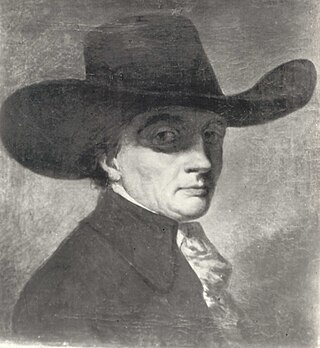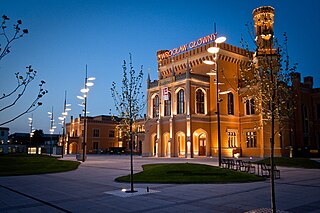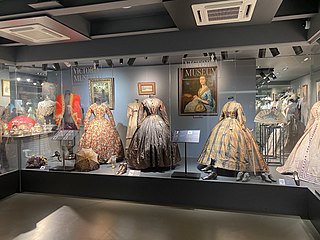
Opole is a city located in southern Poland on the Oder River and the historical capital of Upper Silesia. With a population of approximately 127,387 as of the 2021 census, it is the capital of Opole Voivodeship (province) and the seat of Opole County. Its built-up was home to 146,522 inhabitants. It is the largest city in its province.

Lubliniecpronounced[luˈblʲiɲet͡s] is a town in southern Poland with 23,784 inhabitants (2019). It is the capital of Lubliniec County, part of Silesian Voivodeship ; previously it was in Częstochowa Voivodeship (1975–1998).

Żory is a town and city county in Silesian Voivodeship, Poland with 62,848 inhabitants (2021). Previously it was in Katowice Voivodeship (1975–1998). It is located in the historic Upper Silesia region about 30 kilometres (19 mi) southwest of Katowice.

Wronki is a town in the Szamotuły County, western-central Poland, situated in the Greater Poland Voivodeship. It is located close to the Warta River to the northwest of Poznań on the edge of Noteć Forest, and has a population of approximately 11,000.

Jacek Malczewski was a Polish symbolist painter who was one of the central figures of the patriotic Young Poland movement. His creative output combined the predominant style of his times with historical motifs of Polish martyrdom, the romantic ideals of independence, Christian and Greek mythology, folk tales, as well as his love of the natural world. He was the father of painter Rafał Malczewski.

Jean-Pierre Norblin de La Gourdaine was a French painter, draughtsman, engraver and caricaturist. Born in France, from 1774 to 1796 he resided in Poland.

The National Museum in Kraków, popularly abbreviated as MNK, is the largest museum in Poland, and the main branch of Poland's National Museum, which has several independent branches with permanent collections around the country. Established in 1879, the museum consists of 21 departments which are divided by art period: 11 galleries, 2 libraries, and 12 conservation workshops. It holds some 780,000 art objects, spanning from classical archeology to modern art, with special focus on Polish painting. In 2023, the museum was visited by over 1.65 million people, making it the third most-visited art museum in Poland and the 37th most-visited art museum in the world.

The Historical Museum of the City of Kraków in Kraków, Lesser Poland, was granted the status of an independent institution in 1945. Originally, it was a branch of the Old Records Office of Kraków, in operation from 1899.

Puszczykowo is a town in Poznań County, Poland, with 9,331 inhabitants. It is located about 12 km (7.46 mi) south of Poznań, the area is surrounded by the Wielkopolski National Park. From 1934–54, there was a rural village Puszczykowo. From 1975–98 the town administratively belonged to the regional capital Poznań.

Prószków is a town in Opole County, Opole Voivodeship in southern Poland. It is the administrative seat of Gmina Prószków, a Polish/German bilingual commune since 2006.

Palestinian traditional clothing are the types of clothing historically and sometimes still presently worn by Palestinians. Foreign travelers to Palestine in the 19th and early 20th centuries often commented on the rich variety of the costumes worn, particularly by the fellaheen or village women. Many of the handcrafted garments were richly embroidered and the creation and maintenance of these items played a significant role in the lives of the region's women.

Wrocław Główny is the largest and most important passenger train station in the city of Wrocław, in southwestern Poland. Situated at the junction of several important routes, it is the largest railway station in the Lower Silesia Voivodeship, as well as in Poland in terms of the number of passengers serviced.

The National Museum of Ethnography is a museum of ethnography in Warsaw, Poland. It was established in 1888.

Cieszyn folk costume, also known as Valachian, is a Silesian folk costume, which used to be worn within majority of the area of Cieszyn Silesia, but mostly by Cieszyn Vlachs. Taking into consideration ornamentation, cutting and materials, it can be observed that it is a replica of historical costumes of the Renaissance. The male folk costume was worn only to the late 19th century, whereas the female folk costume was more popular and spread in the vicinity of the Wisła, Istebna and Koniaków. Previously in this area the costumes of Silesian Gorals prevailed. Female folk costumes in Cieszyn were subjected to many changes, especially in respect to ornamentations and better quality of materials. Due to its richness and elegance the costume quickly became a target of artists and specialists in folk culture.

National costumes of Poland vary by region. They are typically not worn in daily life but at folk festivals, folk weddings, religious holidays, harvest festivals and other special occasions. The costumes may reflect region and sometimes social or marital status.

Camp: Notes on Fashion was the 2019 high fashion art exhibition of the Anna Wintour Costume Center, a wing of the Metropolitan Museum of Art in New York that houses the collection of the Costume Institute.
The Model as Muse: Embodying Fashion was a fashion exhibition at the Metropolitan Museum of Art that ran from May 6 to August 9, 2009. It focused on iconic fashion models of the twentieth century who inspired fashion in their respective eras. Organized by historical period from 1947 to 1997, the exhibition was made possible by Marc Jacobs with additional funding from Condé Nast. It was curated by Harold Koda and Kohle Yohannan.
AngloMania: Tradition and Transgression in British Fashion was an exhibition curated by Andrew Bolton at the Metropolitan Museum of Art that ran from May 3 to September 4, 2006. The exhibition featured fashion from throughout Europe in the eighteenth-century that was influenced directly by British attitudes, ideas, and trends. However, these were not accurate depictions of British fashion, but idealized depictions of "a nation's notorious vanity, a romance with itself, and the eccentric desire of English designers to re-establish the establishment." The exhibit is composed of nine "theatrical installations containing clothed mannequins and paintings" that contrasted historical and modern aspects of fashion.

Victoria Museum is a museum of historical costume and style in Kyiv, dedicated to the urban European fashion of the Victorian era (1850–1920). It is the first costume and style museum in Ukraine. It is equipped with the most modern requirements. A museum has a climate control system and solar filtration.
























